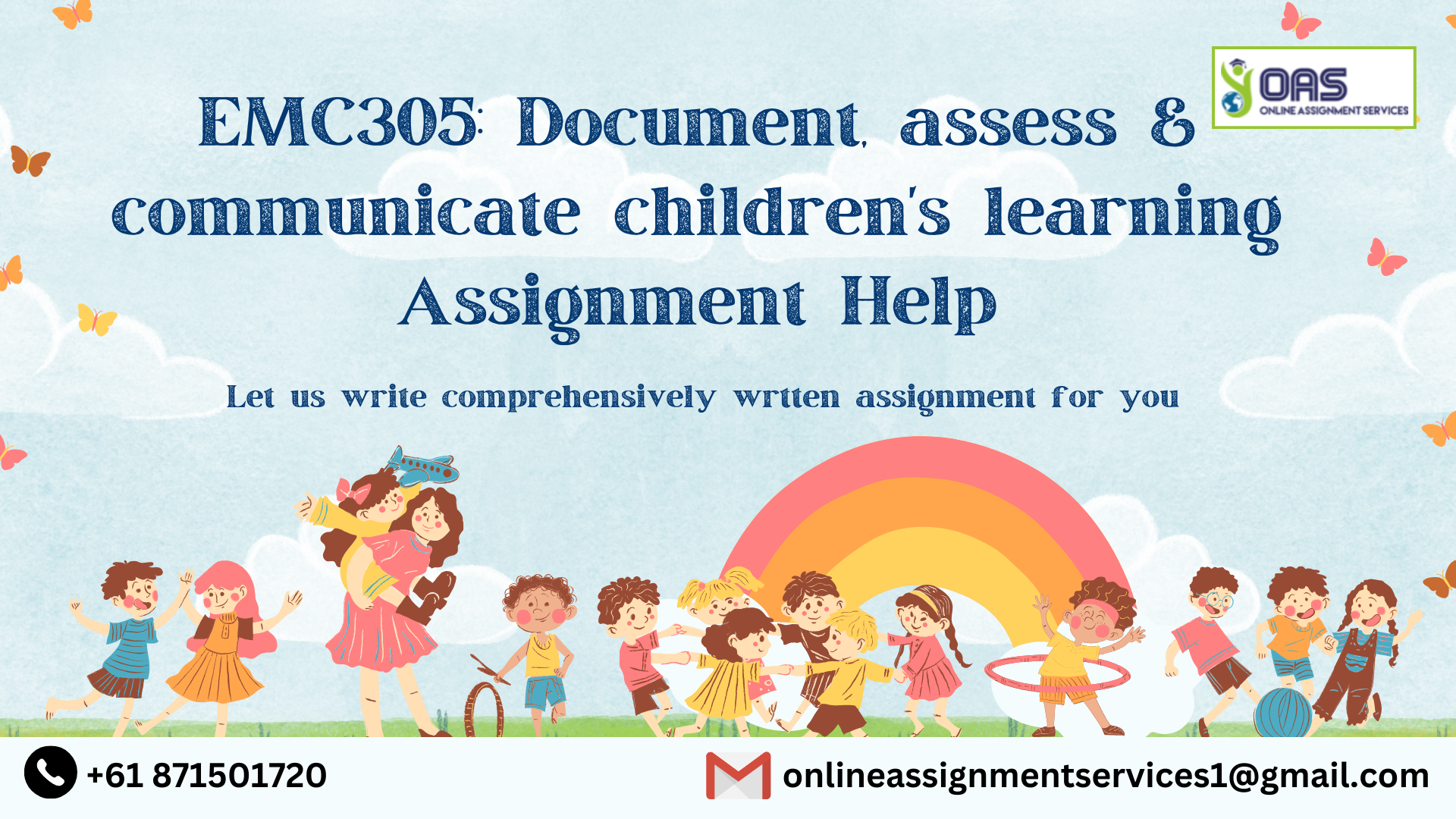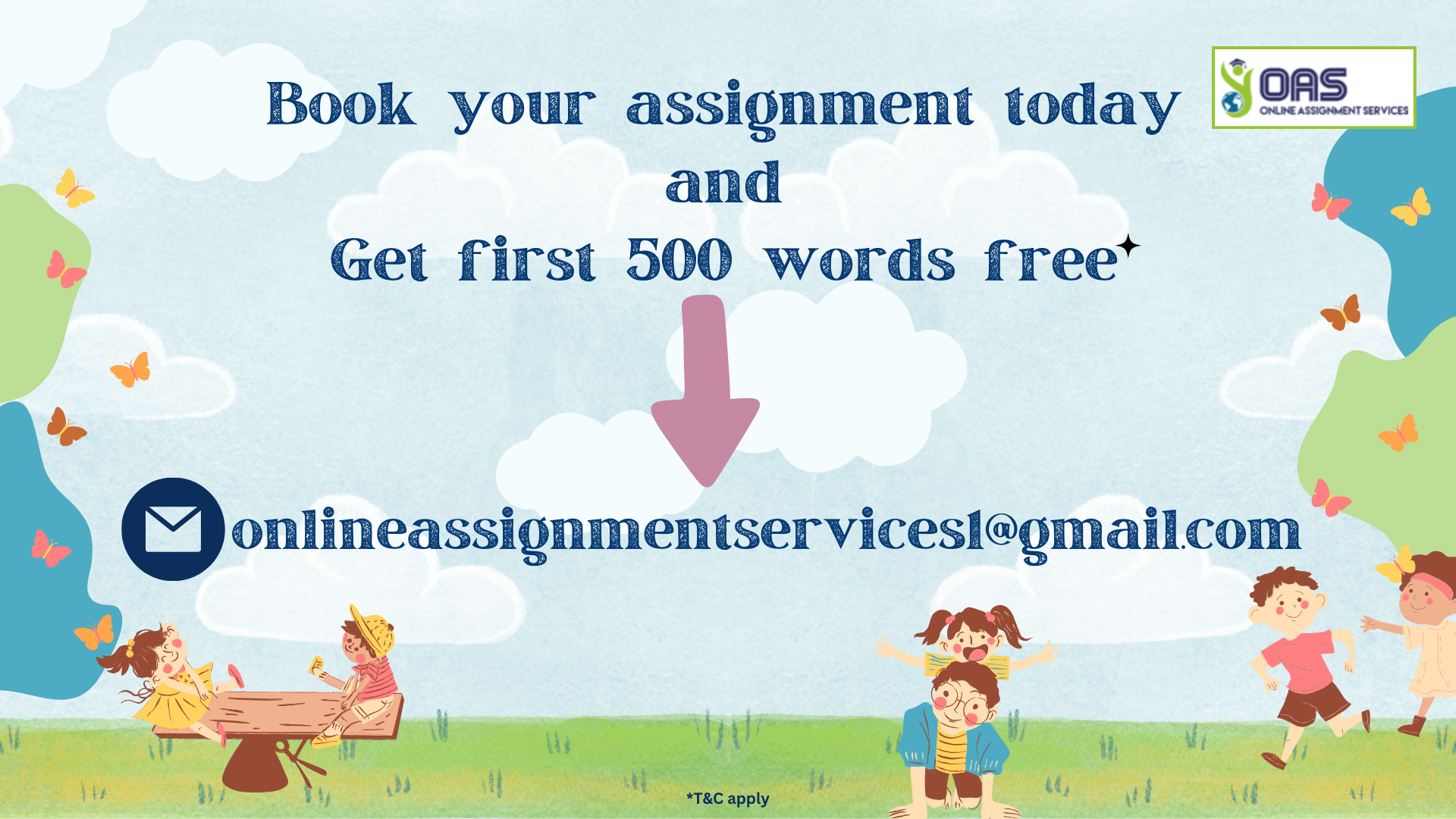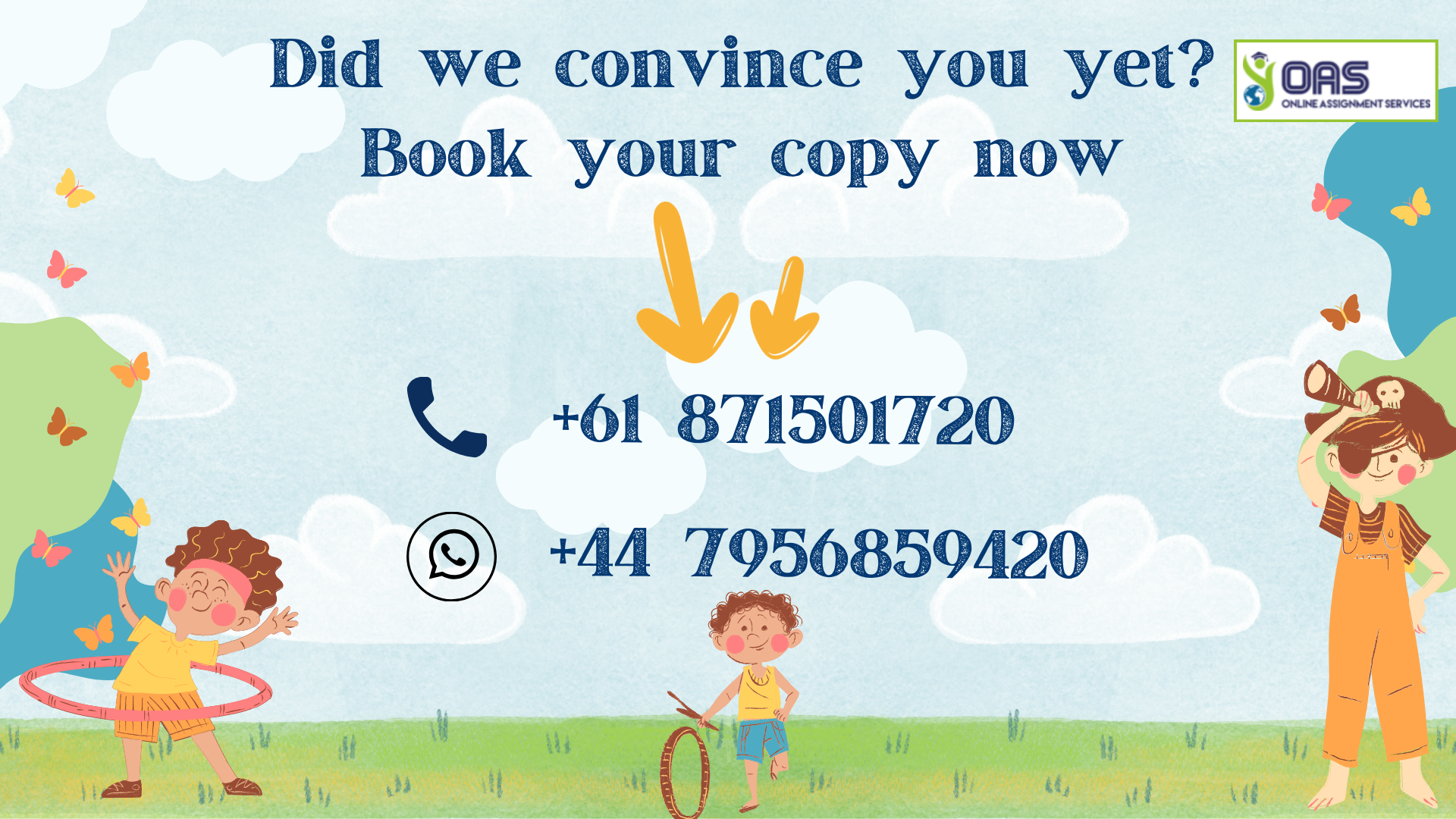EMC305: Document, assess & communicate children’s learning Assignment Help

Question
EMC305: This ‘Investigation: Mathematics, Science and Technology’ assignment for Charles Sturt University requires the student to submit two templates based on observing a child aged up to five years, while he/she is playing solitarily or with a group. Based on these observations, the student is required to write two templates that should depict the child’s learning of science and mathematics. Here, through the templates, the student needs to elaborate on the context in which the child is engaged in the play activity, how mathematics and science learning is demonstrated in the child’s learning, the use of technology and support from the environment in facilitating this learning, specific concepts of the subjects that also need to be communicated to the parents, and lastly some suggestions based providing feedback for the child’s learning.
Solution
The solution incorporates a written document on the two templates for science and mathematics-related learning for the child. Our experts have discussed each required section in-depth to carefully document, assess, and communicate the children’s learning in a structured way. The child observed for this assessment is M (changed name), who is a 3.9-year-old girl. She was observed while she was playing an indoor puzzle game.
Firstly, the mathematics-related template is provided for assessing the children’s learning. This observation and documentation are also supported by theories and concepts from credible researchers.
Template 1
Section 1
The first section of the mathematics template highlights the context in which the little girl was engaged in play.
M, a 3.9-year-old girl was observed during indoor puzzle solving game. She began by counting match sticks before beginning to make a house for her pig cut out. She used terms like “big” “small” “too many” and independently used her imagination to manipulate the straws as primary resource for building the pig house as per the size of the cutout.
Were you looking for a Document, Assess & Communicate Children’s Learning Assignment Help? Give us a call today- +61 871501720.
Section 2
The next section of the template discusses what the child’s play revealed about her learning related to the concepts of mathematics. Here, the assessment and documentation to identify and help children’s learning reveal mathematical concepts about Bishop’s mathematical activities as well.
Engaging with stimulating activities are critical for planning and observing mathematical thinking opportunities that further helps in early mathematic learning (Bjorklund and Pramling, 2017). M was observed to make use of the mathematical concepts and ideas to solve her puzzle of building houses for three different sizes of pig using multiple resources. Apart from critical thinking and problem-solving skills, M reflected universal mathematic activities as given by Alan Bishop (1998). M expressed numerical quantifiers and qualifiers when she identified sizes of cut out from being small to big, she even used combination of sticks to create a pig house reflecting counting activity.
This is only 50% of the complete solution which involves observation and documentation of the child’s mathematics-related learning. If you wish to read the complete answer, reach out to us at onlineassignmentservices1@gmail.com.
Section 3
Through observation and documentation, our experts have revealed the role played by technology in facilitating their learning of mathematical activities. You can read some parts of this complete section below:
Use of technology is known to strengthen the relationship between mathematic knowledge and its practice (Novita and Herman, 2021). Technology is not limited to devices but way people have knowledge of how to do things and further make things (Verbeek, 2011).
Want to read more examples of documentation in Early Childhood? Don’t hesitate to WhatsApp us at +447956859420.
Section 4
Section 4 of the template provides how the environment of the child has supported their learning. Our experts have also considered the role played by adults in encouraging learning among children.
Arrangement of a room for play activities play a critical role in social and language interactions further facilitating enhanced learning for children (French et al. 2020). Children in age group similar as M, need space when playing or learning to be able to explore, discover and experiments with things around them and create opportunities for new learnings and skills (Barrett et al. 2019). An independent activity area was set up to take place inside the classroom and each child was given well defined space in the learning area to face the instruction board. With this adequate lighting, ventilation, and safe resources were ensured for each child to enhance engagement.
Like our high-quality document, assess and Communicate Children’s learning assignment help? Call us today at +61 871501720.
Section 5
Through this section, our experts have linked the child’s learning of the Bishop activities to the learning outcomes defined by the EYLF outcomes. This correlation is also supported by relevant examples from the child’s play that were observed.
M demonstrated ‘explaining’ when she developed logical aspect like big pig would need bigger house in comparison to the smaller pig to be safe from wolves. This resonates with the EYLF Learning Outcome 4, that suggests that children are confidence and involved learners where they adapt to different contexts and connect places and materials to form association (AGDE, 2022).
If you also need assistance with your assignment, don’t hesitate to WhatsApp us at +447956859420.
Section 6
The next section of the template for mathematical learning provides a paragraph highlighting the child’s learning related to Bishop’s activities which will be explained to the parents. This includes how these learning processes can be further used by the patients to enhance the child’s learning endeavors in the future.
M reflects an enterprising personality with ability to make logical connections and identify patterns and quantify resources with her ability to count correctly. M also withholds capability to express her ideas with help of positioning objects in spatial environment and express symbolic plan with use of resources
Interested in reading more examples of documentation in early childhood that helps in the facilitation of a child’s learning? Wait no more, and call us at +61 871501720 today.
Section 7
The last section of the template presents feedback for the child herself about their learning related to the Bishop’s mathematical activities.
M reflects an enterprising personality with ability to make logical connections and identify patterns and quantify resources with her ability to count correctly. M also withholds capability to express her ideas with help of positioning objects in spatial environment and express symbolic plan with use of resources
This brief snippet of the complete solution has been presented for guidance purposes only. Need assistance with your assignment? Reach out today- onlineassignmentservices1@gmail.com.

This is followed by a template demonstrating a child’s science-related learning through engaging in play.
Template 2
Section 1
In this template, our experts have first defined the context in which the child was playing. Keep reading to know how our experts have written a well-articulated answer within the given word limit.
L is a 4.1-year-old confident and enthusiastic boy, who loves to express his thoughts and ideas openly. In a class activity built on STEM approach to integrate science, technology, engineering and mathematics, children were asked to observe as what happened when water is poured over skillets. Within collaborative activity, L reflected his leadership skill and enthusiasm by labelling all colours within the skillets.
Confused about the context of L’s play? Please feel free to call us at +61 871501720 to know more.
Section 2
Here, through observation and documentation of children’s play, it was revealed that this engagement in play led to the child’s learning of a science concept discussed below, which our experts have elaborated in detail in this section.
5Es science model is an inquiry oriented model developed to help children think and work scientifically by being able to gather and analyse evidence and by communicating their ideas to others (Bybee, 1997). Before and during the STEM activity, L reflected through different E from the 5E’s reflecting high scientific inquiry skills and considerate of the nature of science. For instance, L up took the opportunity of labelling colours before the activity and during the activity he freely expressed his idea associated with skillets and water activity to resonate with concept of “Rainbow”.
This is only 50% of the complete solution. If you wish to read the complete answer, reach out to us at onlineassignmentservices1@gmail.com.
Section 3
Through observation and documentation, our experts have revealed the role played by technology in facilitating their learning of mathematical activities. You can read some parts of this complete section below:
Technology has the ability shape learning and outcomes for children. It can help children apply scientific knowledge and lead to a practical purpose. In this STEM activity, there were no technology used, however, there was social knowledge used where process of diffusion is taught through spread of colour with a small movie clip using classroom projector.
Did you like the answer written by our experts? Let us help you as well. Call us at +61 871501720.
Section 4
The following section analyses the child’s play environment in detail to understand the impact of this on their science-related learning.
Physical and social environment is critical for development of scientific knowledge and behaviour (Obaki, 2017). Ensuring to have designated learning areas can help engage children in learning activities and enhance their ability to acquire knowledge and develop learning skills (Barrett et al., 2019). For this STEM activity, within learning area, there was a designated circle time created for a collaborative learning. The class teacher along with support teachers helped to bring all children to come closer before conducting the experiment at a level where in everybody had ease to see the experiment being conducted.
Were you looking for a Document, Assess & Communicate Children’s Learning Assignment Help? WhatsApp us at +447956859420 today!
Section 5
As it is revealed that the child’s play has helped him develop the concept of 5Es, this section presents a detailed overview of how this relates to the EYLF learning outcomes. Our experts have articulated this paragraph which demonstrates an extensive understanding of the learning outcomes and also depicts careful analysis of the documentation of child’s play.
L reflected high sense of engagement, exploration, explanation, elaboration and evaluation while being involved in the STEM activity. This resonated with the ELYF learning outcome 4 that children are confident and evolved learners (AGDE, 2022). L was quick to resolve the problem in the experiment, investigate what was going on and connected the processed materials with nature through expression like “It’s a rainbow”, “No, its like Fireworks.
This is only a snippet of the complete answer written by our expert. Call us at +61871501720 to read more.
Section 6
In this section, the experts explain the concepts of 5Es to the child’s parents in addition to explaining the actions that can be taken to improve the child’s learning.
Every child when supported to think and work in a manner where they can gather data or evidences and analyse information, they are able to develop effective scientific knowledge along with communication skills (Sliogeris & Almeida, 2019). L is actively engaged in learning process where he has strong inquiry skills and understanding of the nature of the formal investigations.
Do you also feel stuck with your assignment? Let us help you. Reach out today- onlineassignmentservices1@gmail.com.
Section 7
This last section for the science template presents feedback for the child which will enhance the child’s knowledge of how much their learnings were justified and what dimensions could have been improved.
Dear L, you express yourself so well and we are proud of you. Your brain must be working hard to help you figure out the results from the experiment conducted. I loved when you corrected yourself when the experiment changed with oil and instead of calling it rainbow, you were quick to identify those droplets looked like fireworks.
Want to read more? Don’t hesitate to WhatsApp us at +447956859420.

